Co-operative Commonwealth Federation
Co-operative Commonwealth Federation Fédération du Commonwealth Coopératif Parti social démocratique du Canada | |
|---|---|
 Former federal political party | |
| Leader |
J. S. Woodsworth, M.J. Coldwell, Hazen Argue |
| Chairman |
J. S. Woodsworth, M. J. Coldwell, F. R. Scott, Percy Wright, David Lewis |
| Secretary |
M. J. Coldwell, David Lewis, Lorne Ingle, Carl Hamilton |
| Founded | 1932 |
| Dissolved | 1961 |
| Preceded by | Ginger Group, Independent Labour Party |
| Succeeded by | New Democratic Party |
| Headquarters | Ottawa, Ontario |
| Ideology |
Social democracy Democratic socialism Agrarianism[1] |
| Political position | Left-wing |
| International affiliation | Socialist International |
| Colours | Green and Yellow |
The Co-operative Commonwealth Federation (CCF) (French: Fédération du Commonwealth Coopératif, from 1955 the Parti social démocratique du Canada) was a social-democratic[2] and democratic socialist[3] political party in Canada. The CCF was founded in 1932 in Calgary, Alberta, by a number of socialist, agrarian, co-operative, and labour groups,[4] and the League for Social Reconstruction. In 1944, the CCF formed the first social-democratic government in North America when it was elected to form the provincial government in Saskatchewan.[5] In 1961, the CCF was succeeded by the New Democratic Party (NDP). The full, but little used, name of the party was Co-operative Commonwealth Federation (Farmer-Labour-Socialist).[6]
Origins
The CCF aimed to alleviate the suffering that workers and farmers, the ill and the old endure under capitalism, seen most starkly during the Great Depression, through the creation of a Co-operative Commonwealth, which would entail economic co-operation, public ownership of the economy, and political reform.
The Co-operative Commonwealth was defined as a "community freed from the domination of irresponsible financial and economic power in which all social means of production and distribution, including land, are socially owned and controlled either by voluntarily organized groups of producers and consumers or - in the case of major public services and utilities and such productive and distributive enterprises as can be conducted most efficiently when owned in common - by public corporations responsible to the people's elected representatives."[7] Many of the party's first Members of Parliament (MPs) were members of the Ginger Group, composed of United Farmers of Alberta, left-wing Progressive, and Labour MPs. These MPs included United Farmers of Alberta MPs William Irvine and Ted Garland, Agnes Macphail (UFO), Humphrey Mitchell, Abraham Albert Heaps, Angus MacInnis, and Labour Party MP J. S. Woodsworth. Also involved in founding the new party were members of the League for Social Reconstruction (LSR), such as F. R. Scott and Frank Underhill.[8] It can be said that the CCF was founded on May 26, 1932, when the Ginger Group MPs and LSR members met in William Irvine's office, the unofficial caucus meeting room for the Ginger Group, and went about forming the basis of the new party.[9] J. S. Woodsworth was unanimously appointed the temporary leader until they could hold a founding convention.[9] The temporary name for the new party was the Commonwealth Party.[10]
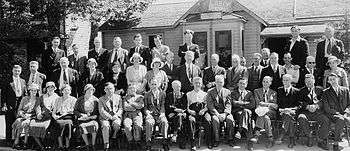
At its founding convention in 1932 in Calgary, the party settled on the name "Co-operative Commonwealth Federation (Farmer-Labour-Socialist)" and selected J. S. Woodsworth as party leader.[11] Woodsworth had been an Independent Labour Party MP since 1921 and a member of the Ginger Group of MPs. The party's 1933 convention, held in Regina, Saskatchewan, adopted the Regina Manifesto as the party's program. The manifesto outlined a number of goals, including public ownership of key industries, universal public pensions, universal health care, children's allowances, unemployment insurance, and workers' compensation.[12]
Its conclusion read, "No CCF Government will rest content until it has eradicated capitalism and put into operation the full programme of socialized planning which will lead to the establishment in Canada of the Co-operative Commonwealth."[11] The party affiliated to the Socialist International.[13]
Electoral performance
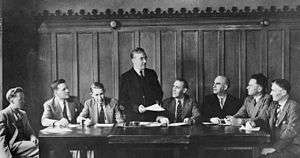
In line with Alberta's important role in founding the CCF, it is said that the first CCF candidate elected was Chester Ronning in the Alberta provincial constituency of Camrose, in October 1932.[15] The UFA, under whose banner he contested the election, formalized its already-strong connection to the CCF in its next provincial convention, in January 1933.[16]
In its first federal election, seven CCF MPs were elected to the House of Commons in 1935. Eight were elected in the following election in 1940, including their first member east of Manitoba, Clarence Gillis, in Nova Scotia's Cape Breton South district. The party was divided with the outbreak of World War II: Woodsworth was a passionate pacifist, and this upset many supporters of the Canadian war effort. Woodsworth had a physically dehabilitating stroke in May 1940 and could no longer perform his duties as leader.[17] In October, Woodsworth wrote a letter to the 1940 CCF convention, in essence asking to retire from the leadership.[17] Instead, the delegates created the new position of Honorary President, abolished the President's position and re-elected M. J. Coldwell as the National Chairman.[17] Coldwell was then appointed acting House Leader on 6 November.[18] Woodsworth died on 21 March 1942, and Coldwell officially became the new leader at the July convention in Toronto and threw the party's support behind the war effort.[18] As a memorial to Woodsworth, Coldwell suggested that the CCF create a research foundation, and Woodsworth House was established in Toronto for that purpose.[17] The party won a critical York South by-election on 8 February 1942, and in the process prevented the Conservative leader, former Prime Minister Arthur Meighen, from entering the House of Commons. In the 1945 election, 28 CCF MPs were elected, and the party won 15.6% of the vote.
However, the party was to have its greatest success in provincial politics in the 1940s. In 1943, the Ontario CCF became the official opposition in that province, and in 1944 the Saskatchewan CCF formed the first socialist government in North America, with Tommy Douglas as premier. Douglas introduced universal Medicare to Saskatchewan, a policy that was soon adopted by other provinces and implemented nationally by the Liberal Party of Canada during the administration of Prime Minister Lester B. Pearson.
Federally, during the Cold War, the CCF was accused of having Communist leanings. The party moved to address these accusations in 1956 by replacing the Regina Manifesto with a more moderate document, the Winnipeg Declaration. Nevertheless, the party did poorly in the 1958 election, winning only eight seats.
After much discussion, the CCF and the Canadian Labour Congress decided to join forces to create a new political party that could make social democracy more popular with Canadian voters. This party, the New Democratic Party (NDP), was founded in 1961. The CCF dissolved itself and was folded into the NDP. While the NDP does not claim the CCF's history as its own, most of the NDP's provincial branches claim to be the successors of the provincial CCF branches.
Federal election results 1935–58
| Election | Leader | # of candidates nominated | # of seats won | # of total votes | % of popular vote |
|---|---|---|---|---|---|
| 1935 | J.S. Woodsworth | 117 | 7[lower-alpha 1] | 386,253 | 8.78% |
| 1940 | J.S. Woodsworth | 94 | 8 | 388,058 | 8.42% |
| 1945 | M.J. Coldwell | 205 | 28 | 815,720 | 15.55% |
| 1949 | M.J. Coldwell | 181 | 13 | 785,910 | 13.42% |
| 1953 | M.J. Coldwell | 170 | 23 | 636,310 | 11.28% |
| 1957 | M.J. Coldwell | 162 | 25 | 707,828 | 10.71% |
| 1958 | M.J. Coldwell | 169 | 8 | 692,668 | 9.49% |
Organization
The CCF estimated its membership as being slightly more than 20,000 in 1938, less than 30,000 in 1942, and over 90,000 in 1944.[20] Membership figures declined following World War II to only 20,238 in 1950 and would never again reach 30,000[20]
By the late 1940s the CCF had official or unofficial weekly newspapers in Alberta, British Columbia, and Saskatchewan; twice-monthly papers in Ontario and Manitoba; and a bimonthly in the Maritimes. A French-language paper in Quebec was also attempted at various times. The party also produced many educational books, pamphlets, and magazines, though these efforts declined in the 1950s.
Party leaders
| Picture | Name | Term start | Term end | Riding as leader | Notes |
|---|---|---|---|---|---|
 | J.S Woodsworth | 1 August 1932 | 21 March 1942 | Winnipeg North Centre, Winnipeg Centre, MB | "Temporary leader" from the party's founding meeting on August 1, 1932 until the founding convention in July 1933 when he was elected president (leader) of the CCF. Due to illness, Woodsworth ceased to be parliamentary leader in October 1940. He remained honorary president (leader) of the CCF until his death.[21] |
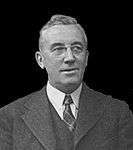 | M.J. Coldwell | July 1942 | 10 August 1960 | Rosetown—Biggar, SK | Became parliamentary leader of the CCF in October 1940. Was unanimously elected party president (leader) at the CCF's national convention in Toronto in July 1942.[21] |
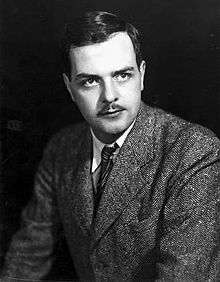 | Hazen Argue | 11 August 1960 | 2 August 1961 | Assiniboia, Wood Mountain, SK | Chosen parliamentary leader by the CCF caucus after Coldwell lost his seat in the 1958 general election. Officially elected party leader, without opposition, at the CCF national convention in 1960. |
National chairmen
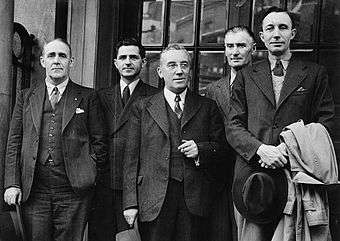
The national chairman was the equivalent of party president in most Canadian political parties and was sometimes referred to as such, in that it was largely an organizational role. In the case of the CCF, the national chairman oversaw the party's national council and chaired its meetings. Following an initial period in which Woodsworth held both roles, it was usually distinct from and secondary to the position of party leader. National president originally was also a title the leader held, as both Woodsworth and Coldwell held the title when they held seats in the House of Commons. In 1958, after Coldwell lost his seat, the position of national chairman was merged formally into the president's title and was held by David Lewis.[22]
- J. S. Woodsworth (1932–38)
- M. J. Coldwell (1938–42)
- F. R. Scott (1942–50)[23]
- Percy Wright (1950–54)[24]
- David Lewis (1954–58)[25]
- David Lewis as party president (1958–61)[25]
National secretaries
The national secretary was a staff position (initially part-time, and then full-time beginning 1938) which was responsible for the day-to-day organizing of the party. The national secretary was the only full-time employee at the party's national headquarters until 1943, when a research director, Eugene Forsey, and an assistant to the leader were hired.
- M. J. Coldwell (1934–36)
- David Lewis (1936–50)[23]
- Lorne Ingle (1950–58)[26][27]
- Carl Hamilton (1958–61)[28]
CCF song
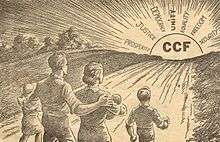
The CCF had a song, which would be later popularized by the movie Prairie Giant: The Tommy Douglas Story.
First verse:
- A call goes out to Canada
- It comes from out the soil—
- Come and join the ranks through all the land
- To fight for those who toil
- Come on farmer, soldier, labourer,
- From the mine and factory,
- And side by side we'll swell the tide—
- C.C.F. to Victory.[29]
Provincial sections
- Alberta CCF
- British Columbia CCF
- Manitoba CCF
- New Brunswick CCF
- Newfoundland CCF/Newfoundland Democratic Party
- Nova Scotia CCF
- Ontario CCF
- Prince Edward Island CCF
- Parti social démocratique du Québec (CCF in Quebec)
- Saskatchewan CCF
See also
- List of articles about CCF/NDP members
- List of articles about British Columbia CCF/NDP members
- List of articles about Alberta CCF/NDP members
- List of articles about Saskatchewan CCF/NDP members
- List of articles about Manitoba CCF/NDP members
- List of articles about Ontario CCF/NDP members
- List of articles about Newfoundland and Labrador CCF/NDP members
- List of articles about Nova Scotia CCF/NDP members
- List of articles about Yukon NDP members
- Labour Party (Canada)
- New Democratic Party
- United Farmers
- Canadian Labour Congress
- Paper Wheat
References
Notes
- ↑ Not including Agnes Macphail who worked with the CCF but was elected as a United Farmers of Ontario-Labour MP.[19]
Citations
- ↑ Seymour Martin Lipset (1971). Agrarian Socialism: The Cooperative Commonwealth Federation in Saskatchewan : a Study in Political Sociology. University of California Press. ISBN 978-0-520-02056-6. Retrieved 20 August 2012.
- ↑ These sources describe the CCF as a social-democratic political party:
- Bryan Evans; Ingo Schmidt (2012). Social Democracy After the Cold War. Athabasca University Press. p. 47. ISBN 978-1-926836-87-4. Retrieved 17 August 2012.
- Rand Dyck (2011). Canadian Politics. Cengage Learning. p. 219. ISBN 978-0-17-650343-7. Retrieved 17 August 2012.
- M. O. Dickerson; Thomas Flanagan; Brenda O'Neill (2009). An Introduction to Government and Politics: A Conceptual Approach. Cengage Learning. p. 169. ISBN 978-0-17-650042-9. Retrieved 17 August 2012.
- Craig Heron; Robert Storey (1986). On the Job: Confronting the Labour Process in Canada. McGill-Queens. p. 21. ISBN 978-0-7735-0599-5. Retrieved 17 August 2012.
- Norman Penner (1992). From Protest to Power: Social Democracy in Canada 1900-Present. James Lorimer & Company. p. 86. ISBN 978-1-55028-384-6. Retrieved 19 August 2012.
- ↑ The following sources describe the CCF as a democratic socialist political party:
- Robert Bothwell; Ian M. Drummond; John English (1989). Canada Since 1945: Power, Politics and Provincialism. University of Toronto Press. p. 149. ISBN 978-0-8020-6672-5. Retrieved 20 August 2012.
- Anthony Hlynka (2005). The Honourable Member for Vegreville: The Memoirs and Diary of Anthony Hlynka, M.P. (1940-49). University of Calgary Press. p. 24. ISBN 978-1-55238-137-3. Retrieved 20 August 2012.
- Callum G. Brown; Michael Snape (2010). Secularisation in the Christian World. Ashgate Publishing, Ltd. p. 106. ISBN 978-0-7546-6131-3. Retrieved 20 August 2012.
- Will Ferguson (2011). Canadian History for Dummies. John Wiley & Sons. p. 200. ISBN 978-0-470-67678-3. Retrieved 20 August 2012.
- Charles D. Ameringer (1992). Political Parties of the Americas, 1980s to 1990s: Canada, Latin America, and the West Indies. Greenwood Publishing Group. p. 157. ISBN 978-0-313-27418-3. Retrieved 20 August 2012.
- Terence Allan Crowley; Murphy, Rae (1993). The Essentials of Canadian History: Pre-colonization to 1867--the Beginning of a Nation. Research & Education Assoc. p. 47. ISBN 978-0-7386-7144-4. Retrieved 5 May 2013.
- ↑ Alvin Finkel (1997). Our Lives: Canada After 1945. James Lorimer & Company. p. 5. ISBN 978-1-55028-551-2. Retrieved 20 August 2012.
- ↑ Peter Davis (1983). Social Democracy in the South Pacific. Peter Davis. p. 53. ISBN 978-0-908636-35-8. Retrieved 17 August 2012.
- ↑ Bleifuss, Joel (2015-10-05). "NDP Rising Star Nathan Cullen on How Republican Tactics are Infecting Canadian Politics, and More". In These Times.
- ↑ Laurence Gronlund, Co-operative Commonwealth, An Exposition of Socialism (1884), p. 36 as quoted in Monto, Tom, Protest and Progress, Three Labour Radicals in Early Edmonton, Crang Publishing/Alhambra Books, p. 156
- ↑ Young (1969), p. 31.
- 1 2 McNaught (2001), pp. 259-260.
- ↑ Young (1969), p. 30.
- 1 2 Morton (1986), p. 12.
- ↑ Young (1969), pp. 304-313.
- ↑ Kenneth Murray Knuttila (2007). The Prairie Agrarian Movement Revisited. University of Regina Press. pp. 173–. ISBN 978-0-88977-183-3.
- ↑ Smith (1992), p. 88.
- ↑ Mardiros, Anthony (1979). William Irvine, The Life of a Prairie Radical. Toronto: James Lorimer & Co. p. 208. ISBN 978-0-8886-2237-2.
- ↑ Champion Chronicle, January 26, 1933
- 1 2 3 4 McNaught (2001), pp. 313-315.
- 1 2 Stewart (2000), pp. 244–245.
- ↑ Stewart & Shackelton (1959), p. 178.
- 1 2 Young (1969), Appendix B, Table III, p. 320.
- 1 2 "Co-operative Commonwelth Federation". Library of Parliament. Parliament of Canada.
- ↑ Young (1969), p. 235.
- 1 2 Braithwaite, Dennis (1950-07-29). "C.C.F. Disavows Marx Class Struggle Idea, Tempers High in Debate". The Toronto Daily Star. pp. 1, 7.
- ↑ Staff (1952-08-09). "Make Own Foreign Policy, Follow U.N. CCF Meet Urges". The Toronto Daily Star. pp. 1, 2.
- 1 2 Stewart (2000), p. 211.
- ↑ Young (1969), p. 127.
- ↑ Smith (1989), p. 294.
- ↑ Stewart (2000), p. 212.
- ↑ "Foreword". CCYM Sings. Saskatchewan Council for Archives and Archivists. Retrieved 2010-07-17. CCYM is the Co-operative Commonwealth Youth Movement, the image is from a larger collection of scans in jpeg format.
Bibliography
- Avakumovic, Ivan (1978). Socialism in Canada : a study of the CCF-NDP in federal and provincial politics. Toronto: McClelland and Stewart. ISBN 978-0-7710-0978-5.
- Azoulay, Dan (1999). "A Desperate Holding Action: The Survival of the Ontario CCF/NDP, 1948–1964". In Azoulay, Dan. Canadian Political Parties: Historical Readings. Toronto: Irwin Publishing. pp. 342–363. ISBN 978-0-7725-2703-5.
- Boyko, John (2006). Into the Hurricane: Attacking Socialism and the CCF. Winnipeg, Canada: J. Gordon Shillingford Publishing. ISBN 978-1-897289-09-9.
- Caplan, Gerald (1973). The Dilemma of Canadian Socialism: The CCF in Ontario. Toronto: McClelland and Stewart. ISBN 978-0-7710-1896-1.
- Douglas, T. C. (Tommy) (1982). Thomas, L. H., ed. The Making of a Socialist. Edmonton: University of Alberta Press. ISBN 9780888640703.
- Horowitz, Gad (1968). Canadian Labour in Politics. Toronto: University of Toronto Press. ISBN 978-0-8020-1902-8.
- Lacroix, Patrick (2016). ""From Strangers to 'Humanity First': Canadian Social Democracy and Immigration Policy, 1932-1961". Canadian Journal of History. 51 (1): 58-82. doi:10.1353/cnh.2016.0028.
- Lewis, David (1981). The Good Fight: Political Memoirs 1909–1958. Toronto: Macmillan of Canada. ISBN 978-0-7715-9598-1.
- Lewis, David; Scott, Frank (2001) [1943]. Make this YOUR CANADA: A Review of CCF History and Policy. Canada: Hybrid Publishers Co-operative Ltd. ISBN 978-0-9689709-0-4.
- MacDonald, Donald C. (1998). The Happy Warrior: Political Memoirs (2 ed.). Toronto, ON, Canada: Dundurn Press. ISBN 978-1-55002-307-7.
- McHenry, Dean Eugene (1950). The Third Force in Canada; the Co-operative Commonwealth Federation 1932–1948. Berkeley: University of California Press.
- McLeod, Thomas; McLeod, Ian (2004). The Road to Jerusalem (2 ed.). Calgary: Fifth House. ISBN 978-1-894856-48-5.
- McNaught, Kenneth (2001). A Prophet in Politics: A Biography of J. S. Woodsworth. With a new introduction by Allen Mills (reprint ed.). Toronto: University of Toronto Press. ISBN 0-8020-3555-8.
- Milligan, Frank (2004). Eugene A. Forsey: An Intellectual Biography. Calgary: University of Calgary Press. ISBN 9781552381182.
- Mills, Allen (1991). Fool for Christ: The Political Thought of J. S. Woodsworth. Toronto: University of Toronto Press. ISBN 9781442623354.
- Morton, Desmond (1986). The New Democrats: 1961-1986 (3 ed.). Toronto: Copp Clark Pitman Ltd. ISBN 0-7730-4618-6.
- Penner, Norman (1988). Canadian Communism: the Stalin years and beyond. Toronto: Methuen. ISBN 978-0-458-81200-4.
- Scott, Frank R. (1986). A New Endeavour: Selected Political Essays, Letters, and Addresses. Edited and introduced by Michiel Horn. Toronto: University of Toronto Press. ISBN 978-0-8020-5672-6.
- Shackleton, Doris French (1975). Tommy Douglas. Toronto: McClelland & Stewart. ISBN 978-0-7710-8116-3.
- Smith, Cameron (1989). Unfinished Journey: The Lewis Family. Toronto: Summerhill Press. ISBN 978-0-929091-04-4.
- Smith, Cameron (1992). Love & Solidarity: A Pictorial History of the NDP. Toronto: McClelland & Stewart. ISBN 978-0-7710-8209-2.
- Stewart, Margaret; Shackelton, Doris French (1959). Ask no quarter; a biography of Agnes Macphail. Toronto: Longmans, Green.
- Stewart, Walter (2000). M.J.: The Life and Times of M.J. Coldwell. Toronto: Stoddart Publishing Co. Limited. ISBN 978-0-7737-3232-2.
- Stewart, Walter (2003). Tommy: the life and politics of Tommy Douglas. Toronto: McArthur & Company. ISBN 978-1-55278-382-5.
- Trofimenkoff, Susan Mann (1982). Stanley Knowles: The Man from Winnipeg North Centre. Saskatoon: Western Producer Prairie Books. ISBN 9780888331007.
- Young, Walter D. (1969). The anatomy of a party: the national CCF 1932–61. Toronto: University of Toronto Press.
External links
- The Prairie Roots of Canada's Political 'Third Parties'
- Tommy Douglas: "Greatest Canadian" feature article from the Canadian Encyclopedia
- The Co-operative Commonwealth Federation (CCF) and the New Democratic Party (NDP): their Failure in Quebec, 1932-1997
Archives
- George E. Rennar Papers. 1933-1972. 37.43 cubic feet. At the Labor Archives of Washington, University of Washington Libraries Special Collections. Contains ephemera on the Cooperative Commonwealth Federation from 1933, 1942-1944.
| Preceded by Ginger Group |
Co-operative Commonwealth Federation 1932 - 1961 |
Succeeded by New Democratic Party |
